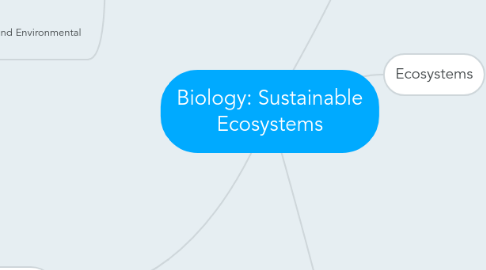
1. Interactions in Ecosystems
1.1. Biotic Interactions
1.1.1. Predation happens when one organism eats another.
1.1.2. Competition is the interaction between two or more organisms competing for the same resource.
1.1.3. Symbiosis is the close interaction between two different species
1.2. Population Growth
1.2.1. J-Curve is exponential growth
1.2.2. Boom and Bust is sudden growth and then sudden decline
1.2.3. S-Curve is sudden then Plateaued growth
1.3. Limiting Factors
1.3.1. Biotic: Competition, predation, and parasitism and disease
1.3.2. Abiotic: Human disturbances and forest fires and other extreme climates
2. The Effects of Human Activity on Ecosystems
2.1. Impacts on Biodiversity
2.1.1. Extinction
2.1.2. Decrease in biodiversity: habitat change, overexploitation, pollution, invasive species, and climate change.
2.2. Impacts on Ontario Ecosystems
2.2.1. Stresses on freshwater lakes
2.2.2. Motor boats can leak oil into a lake and contaminate it
2.2.3. Beaches cause loss of habitats
2.3. Bioaccumulation and Biomagnification
2.3.1. Bioaccumulation is the gradual buildup of substances.
2.3.2. Biomagnification is a substance that becomes more concentrated from each link in the food chain.
3. Organizations for Sustainability
3.1. The Convention on Biological Diversity
3.1.1. An agreement that tries to conserve Earth's biodiversity sustainably
3.2. Environmental Farm Plan
3.2.1. A plan that allows farmers to identify environmental problems and develop solutions for them
3.2.2. Integrated pest management uses common sense to identify environmental problems and develop solutions for them
3.2.3. Soil conservation protects soil from erosion and loss of minerals
3.2.4. Organic farming is when no chemical fertilizers or pesticides are used and reduces water pollution.
3.3. Forest Stewardship Council
3.3.1. It is a non-governmental organization
3.3.2. Certifies forests and forestry practices
3.3.3. Labels wood products
3.4. Leadership in Energy and Environmental Design
3.4.1. Rates reduction of water consumption
3.4.2. Reuse of existing buildings
3.4.3. Incorporate daylight
4. Ecosystems
4.1. Elements of an Ecosystem
4.1.1. Abiotic: Things that are not living
4.1.2. Biotic: Things that are living
4.2. Biomes and Bioshpere
4.2.1. Terrestrial biome: Communities on land
4.2.2. Aquatic biome: Communities under water
4.2.3. 3 main components: atmosphere, lithosphere, and hydrosphere.
4.3. Nutrients
4.3.1. Substances that an organism uses to build and repair the cells of its body.
4.4. The Nutrient Cycles
4.4.1. 3 types of bacteria: nitrogen-fixing bacteria, nitrifying bacteria, and denitrifying bacteria.
4.4.2. Animals get nitrogen by eating plants that have already absorbed the nitrogen.
4.4.3. Water cycle: evaporation, transpiration, condensation, precipitation, run-off, seepage, root uptake, aquifer.
4.5. Photosynthesis/Cellular Respiration
4.5.1. Plants use photosynthesis to capture energy
4.5.2. Plants use photosynthesis to capture the energy from glucose
4.5.3. Producers carry out photosynthesis and Consumers eat other organisms.
4.6. Food Chains and Food Webs
4.6.1. Food webs shows difficult feeding relationships
4.6.2. Energy pyramids: 60% passed out as waste, 30% used in the body processes, 10% stored in body tissue.
4.6.3. Producers eat primary consumers eat secondary consumers eat tertiary consumers
